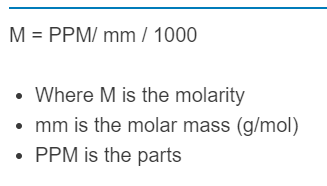

This can be done using the calculator above. It is technically wrong not to add the solute and solvents together to determine the mass of solution. Even though mathematically it didnt change a thing. Second, multiply the number you got in step one by 1,000,000. Answer-The equation above reads 'grams of solution', you had to add the solute to the solvent in the denominator. For example, the number of carbon atoms per amount of soil. Most often this is a number of atoms in some unit of volume or solution. Follow manufacturer’s safety instructions on the product label and refer to Material Safety Data Sheet for further details on handling. First, you must determine the number you wish you calculate the parts per million of. Always add the bleach solution to the water when preparing the solution, not vice versa. Mixing bleach and acid generates a very toxic chlorine gas. Never mix acid products with bleach or bleach-containing products.

It is recommended that you verify the strength of your chlorine solution with chlorine test strips or titration kits. This tool was developed to assist Environmental Health Officers, food establishment operators, care facility operators, swimming pool operators, and the public to prepare the appropriate concentration of chlorine solution using bleach (sodium hypochlorite). Put a sample of the colloidal copper solution in the flask. Measure and record the weight of an empty flask. ppm is usually a molar ratio: 1 mole substance per 1x106 moles of total solution. Measure and record the density of the colloidal copper solution (in grams per liter). Typically colloidal copper is sold in dilute quanitities (like 100 ppm). The basic formula for PPM starts with dividing the weight or number of defects by the volume and then multiplying the result by 1,000,000. ppm or What is that in moles per liter On-the-spot conversion calculations are time-consuming, difficult, and often inaccurate. This easy-to-use calculator tells you how much liquid bleach to add to water to get your desired concentration (ppm) of chlorine solution. Note: colloidal copper is small flecks of copper mixed with purified water. Parts per million calculations are used for measuring small concentrations in a solution, solid and gas or the number of defects in manufacturing.


 0 kommentar(er)
0 kommentar(er)
